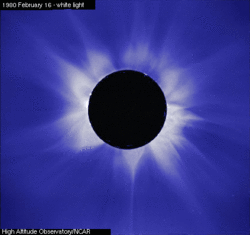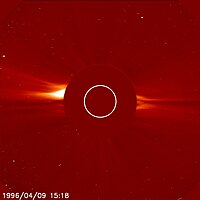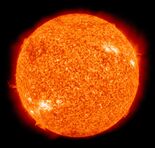Helmet streamer
Topic: Astronomy
 From HandWiki - Reading time: 5 min
From HandWiki - Reading time: 5 min
Helmet streamers, also known as coronal streamers, are elongated cusp-like structures in the Sun's corona which are often visible in white-light coronagraphs and during solar eclipses. They are closed magnetic loops which lie above divisions between regions of opposite magnetic polarity on the Sun's surface. The solar wind elongates these loops to pointed tips which can extend a solar radius or more into the corona.[1]
During solar minimum, helmet streamers are found closer to the heliographic equator, whereas during solar maximum they are found more symmetrically distributed around the Sun.
Structure
Helmet streamers have cusp-like bases that taper radially outward away from the Sun forming long stalks. The base typically extends up to 1.5 solar radii above the surface, whereas the stalk—stretched outward by the solar wind—can extend over many solar radii.[2]
Helmet streamers are structured by closed magnetic fields and lie above boundaries separating opposite magnetic polarity in the Sun's photosphere. Their thin stalks consist of oppositely directed magnetic fields which form current sheets.[3] Surrounding these stalks are open, oppositely directed magnetic fields which are anchored to coronal holes lower in the corona.[4]
The white-light emissions of helmet streamers is due to the high electron density of the confined plasma relative to the surrounding corona. Light from the photosphere is Thompson scattered off of these electrons with the intensity of scattered light depending on the number of electrons along the observer's line of sight.[5]
Small blobs of plasma, or "plasmoids" are sometimes released from the tips of helmet streamers, and this is one source of the slow component of the solar wind.[1][better source needed]
Solar cycle
Around solar minimum, the point of minimum solar activity during the 11-year solar cycle, helmet streamers are generally located around the heliographic equator in what is referred to as the streamer belt. At the same time, large coronal holes are present at the poles. As solar activity increases near the solar maximum, helmet streamers appear more symmetrically around the Sun.[3]
Role in coronal mass ejections
File:Parker Solar Probe Encounters Streamers on the Way to the Sun.webm
Upon the eruption of a coronal mass ejection (CME), the overlying helmet streamer deforms becoming the CME's leading edge. Similarly, the helmet streamer's cavity becomes the CME's cavity and the helmet streamer's prominence becomes the CME's core.[5]
Pseudostreamers
Structures in the corona, similar to a helmet streamer, but connecting holes of the same magnetic polarity, are called pseudostreamers.[6][7][8][9] They were first observed using space-borne coronagraphs and called a "plasma sheets" by Hundhausen (1972). They were later renamed to "unipolar streamers" by Zhao & Webb (2003) and then termed "pseudostreamers" by Wang et al. (2007).[6] Pseudostreamers' structure was observed in 2012 by the Solar Dynamics Observatory.[8]
Magnetic topology of pseudostreamers was described as "contain[ing] twin filaments at its base. Such twin filaments are topologically connected, sharing a neutral point and a separatrix dome. This was a case in which two polarity reversal boundaries contain between them fields with a polarity opposite to that of the global unipolar configuration surrounding them (tripolar pseudostreamer)."[9]
Single hybrid magnetic structure that consists of double-streamer/pseudostreamer was observed in the solar corona on May 5-10, 2013 by the SWAP instrument of the PROBA2 satellite. Its structure was described by researchers:[10]
It consists of a pair of filament channels near the south pole of the Sun. On the western edge of the structure, the magnetic morphology above the filaments is that of a side-by-side double streamer, with open field between the two channels. On the eastern edge, the magnetic morphology is that of a coronal pseudostreamer without the central open field.
See also
References
- ↑ 1.0 1.1 Kallenrode, May-Britt (2004). Space Physics: An Introduction to Plasmas and Particles in the Heliosphere and Magnetospheres. Berlin: Springer. p. 145. ISBN 3-540-20617-5. https://archive.org/details/spacephysics00kall.
- ↑ Koutchmy, Serge; Livshits, Moissei (1992). "Coronal streamers". Space Science Reviews 61 (3–4): 393. doi:10.1007/BF00222313. Bibcode: 1992SSRv...61..393K. https://link.springer.com/article/10.1007/BF00222313. Retrieved 30 July 2022.
- ↑ 3.0 3.1 Wang, Y.-M.; Sheeley, N. R.; Socker, D. G.; Howard, R. A.; Rich, N. B. (1 November 2000). "The dynamical nature of coronal streamers". Journal of Geophysical Research: Space Physics 105 (A11): 25133–25142. doi:10.1029/2000JA000149. Bibcode: 2000JGR...10525133W.
- ↑ Cranmer, Steven R. (2009). "Coronal Holes". Living Reviews in Solar Physics 6 (1): 3. doi:10.12942/lrsp-2009-3. PMID 27194961. Bibcode: 2009LRSP....6....3C.
- ↑ 5.0 5.1 Gopalswamy, N. (January 2003). "Coronal mass ejections: Initiation and detection". Advances in Space Research 31 (4): 869–881. doi:10.1016/S0273-1177(02)00888-8. Bibcode: 2003AdSpR..31..869G. https://cdaw.gsfc.nasa.gov/publications/gopal/gopal2003AdvSpRes31_869.pdf. Retrieved 27 August 2021.
- ↑ 6.0 6.1 Scott, Roger B.; Pontin, David I.; Antiochos, Spiro K.; DeVore, C. Richard; Wyper, Peter F. (1 May 2021). "The Dynamic Formation of Pseudostreamers". The Astrophysical Journal 913 (1): 64. doi:10.3847/1538-4357/abec4f. Bibcode: 2021ApJ...913...64S. https://discovery.dundee.ac.uk/en/publications/fdb4f5d7-e55e-415a-94ec-aedc4eece448.
 Material was copied from this source, which is available under a Creative Commons Attribution 4.0
Material was copied from this source, which is available under a Creative Commons Attribution 4.0
- ↑ Wang, Y.‐M.; Sheeley, Jr., N. R.; Rich, N. B. (April 2007). "Coronal Pseudostreamers". The Astrophysical Journal 658 (2): 1340–1348. doi:10.1086/511416. Bibcode: 2007ApJ...658.1340W. https://iopscience.iop.org/article/10.1086/511416/fulltext/.
- ↑ 8.0 8.1 Masson, Sophie; McCauley, Patrick; Golub, Leon; Reeves, Katharine K.; DeLuca, Edward E. (13 May 2014). "Dynamics of the Transition Corona". The Astrophysical Journal 787 (2): 145. doi:10.1088/0004-637X/787/2/145. Bibcode: 2014ApJ...787..145M.
- ↑ 9.0 9.1 Panasenco, Olga; Martin, Sara F.; Velli, Marco; Vourlidas, Angelos (2012). "Origins of Rolling, Twisting, and Non-radial Propagation of Eruptive Solar Events". Solar Physics 287 (1–2): 391–413. doi:10.1007/s11207-012-0194-3.
- ↑ Rachmeler, L. A.; Platten, S. J.; Bethge, C.; Seaton, D. B.; Yeates, A. R. (1 May 2014). "Observations of a Hybrid Double-streamer/Pseudostreamer in the Solar Corona". The Astrophysical Journal 787: L3. doi:10.1088/2041-8205/787/1/L3. ISSN 0004-637X. https://iopscience.iop.org/article/10.1088/2041-8205/787/1/L3. Retrieved 10 March 2023.
 |
 KSF
KSF




